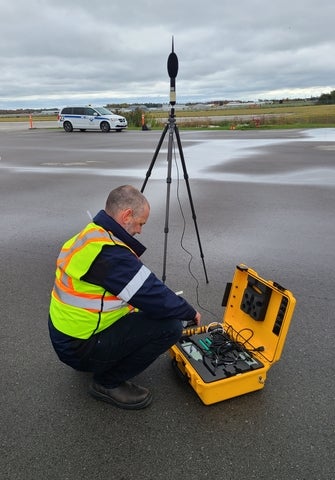
Noisy neighbours: Do electric aircraft reduce airport noise pollution?
Noise complaints are a common issue around airports. Even where airports were initially built outside of cities, suburbs have often grown to reach or surround them. As a result, many more people are exposed to the noise from aircraft flying overhead, and complaints arise. Most airport authorities have noise reduction strategies including designated flight paths and restricted hours. An extreme example is rural airports in Switzerland, where weekend flights are prohibited because of the noise.
Electric aviation offers another solution by replacing the noisy fossil fuel engine with a quiet electric motor. Of course, there is still noise from the propeller, so how big is the reduction in noise by changing to electric power?

Setting up audio equipment on the runway
The Region of Waterloo International Airport is typical of regional airports where actions have been taken to reduce noise, but complaints are still common. The University of Waterloo operates their Pipistrel Velis Electro at this airport, so the airport staff partnered with the University’s research team to make systematic noise measurements. As noise levels decrease with distance and altitude, we wanted to measure the noise when the aircraft were close to the ground. We chose two locations for the measuring equipment: first, at the end of the runway where the planes were coming in to land, and second, at the end of the runway where they were taking off and climbing. These points were also closer to the aircraft than actual neighbours’ houses and therefore should represent a louder sound than that experienced by neighbours. Measurements were made of both the Velis Electro and conventional gasoline-powered Cessnas.
The decibel scale, dB, is used to measure sound. A-weighted decibels, abbreviated dBA, are an expression of the relative loudness of sounds in air as perceived by our ears. According to the Centers for Disease Control and Prevention, “Noise above 70 dB over a prolonged period of time may start to damage your hearing. Loud noise above 120 dB can cause immediate harm to your ears.”
Each flight starts with a takeoff and climb, so the team located their microphone at the end of the 4,100-foot runway that the plane flew over and recorded the sound level as the Velis Electro and Cessnas departed. Three Velis flights were recorded and the typical sound level was 20-22 dB. Multiple Cessnas took off with a typical sound level of 50 dB. Clearly the Velis had a much quieter takeoff, and the sound would be lost amongst the background noise of a nearby road. The plane would be higher when it reached neighbours’ houses so the noise level should decline accordingly.
From the ground, directly under the departure path, the difference in subjective noise was remarkable. The gasoline-powered aircraft sounded about as loud as you would imagine, while the electric plane produced a slight whoosh that would struggle to be heard over normal conversation.
Another set of measurements were made near the runway threshold where landing aircraft would fly over just before touching down. Again, several Velis Electro flights were measured for an average sound level of 62 dBA. (See Graph 1.) Similarly, the Cessna flights were measured and averaged to obtain a comparison reading of 71 dBA. Again, the Velis was much quieter than the conventional aircraft. In this case, the Velis is typically descending with minimal power, so most of the noise is created by air flow and vibrations around the extended flaps on the wings. The flaps are extended to reduce the aircraft’s landing speed, but drag and noise increase as a result.

Graph 1. Average peak sound levels (approach)
Interestingly, while taking these landing aircraft measurements, we noticed a Gulf Stream passing overhead at 9,000 feet, and it produced a higher sound level than the Velis passing close overhead to land.
The Velis Electro is an example of a small electric airplane with reduced noise levels during the critical takeoff and landing stages of flight when compared to conventional aircraft. Anecdotal international reports indicate that these lower noise levels enable airports to approve e-plane flights when they might have to restrict conventional aircraft. Similarly, practice flight areas have been approved for e-planes closer to the airport due to the lower noise levels. In these cases, operating procedures have been adapted to reflect the quieter performance of the e-plane. Perhaps, if e-planes become more common, it will also mean fewer noise complaints in the future.
The Pipistrel Velis Electro lands at the Region of Waterloo International Airport